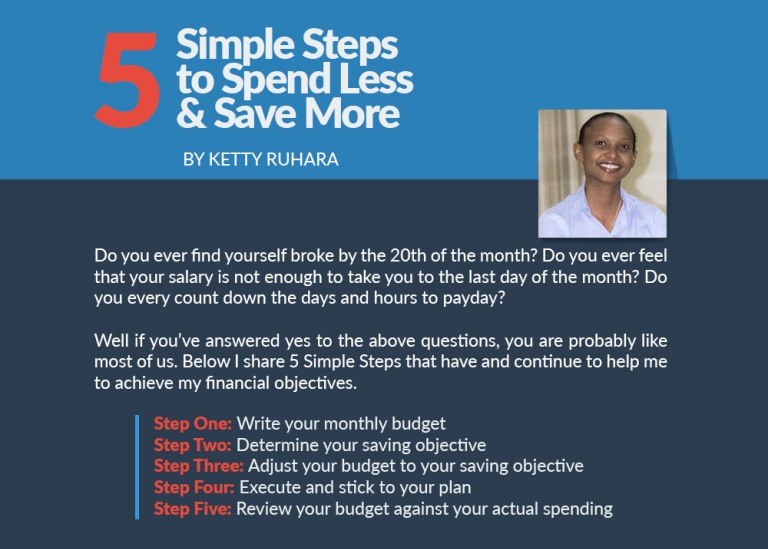Do you ever find yourself broke by the 20th of the month? Do you ever feel that your salary is not enough to take you to the last day of the month? Do you ever count down the days and hours to payday?
Well if you’ve answered yes to the above questions, you are probably like most of us. I my early years, I was certainly in this position as well. I thought that I was simply not earning enough. So I went through life with the desire and objective to earn more money (not implying there is something wrong with that). To my surprise, every time I would get a raise or a better paying job, I would still find myself in the same position: broke by the 20th! So how do we deal with this paradox?
I read this statement a few years ago and it completely changed my perspective: ‘It’s not how much you make that counts, but how much you save’. The simple truth is that wealth is not measured by how much you earn or spend, rather by how much you save and invest. As I came across this principle, I changed my approach and subsequently, have seen better results in my personal finances and ‘broke’ was no longer a word in my vocabulary!
Below I share 5 Simple Steps that have and continue to help me to achieve my financial objectives. Although most of the insights I am about to share might not be new to you, my hope is that it can encourage you, and even better, help you achieve your own financial objectives.
Step One: Write your monthly budget
Most people budget, but very few actually write it down. The danger with this approach is that it makes it more difficult to stick to your plan. In one column, itemize your monthly expenses (rent, school fees, food, transport, communication, entertainment, etc.). In another column, write the amount budgeted for each of those expenses, and add them together to determine your total monthly budget.
Key Point
- Comparing your monthly total expenses against your income(s) will provide you a clear picture of the state of your financial health. Either you are in the red or green!
Step Two: Determine your saving objective
Here you are simply asking yourself ‘how much do I want to save?’ Financial experts recommend between 10-20% of your income.
Key point
- If you do not set a specific amount/percentage, you are not likely to save as much as you would like to.
Step Three: Adjust your budget to your saving objective
Now onto the hard part – Align your budget to your saving objective:
- Incorporate your ‘monthly saving’ in your budget (table in step 1).
- If your new total monthly expenses (including your monthly saving) are higher than your salary, this implies that you need to adjust your budget. Adjusting your budget is more than just cutting your cost or eliminating certain expenses, but also implies prioritizing.
- Adjust / reduce realistically each expense so that all your monthly cost are equal to or less than your income(s). For example, if you earn $100 per month, your total expenses should be equal or less than $100 per month.
Key points
- Turn your desired monthly saving objective into a priority in your budget. Failing to do so, meaning leaving it open ended, will most likely make it easier for you to spend that money on unplanned (and in some cases, unimportant) things.
- Failing to adjust your monthly expenses (including your monthly saving) will make you a ‘borrower’ rather than a ‘lender’ (saver).
Step Four: Execute and stick to your plan
As you begin the month, be alert that you are only spending what you budgeted for. Things will come up that you did not plan for (e.g. your long lost cousin is getting married or you loose someone in your family). Also, most people overspend on their entertainment so be on the look out for that. In the next issue, we will discuss ‘Tips to help you spend less’.
The point is, it is hard to stick to your budget, but with time, you will know how to manage the unexpected in such a way that you meet your obligations and save consistently as well.
Step Five: Review your budget against your actual spending
It is advisable that at the end of each month, you review what you have actually spent against what you budgeted. In the first few months, you might realize you have either under/over estimated some of your expenses. It is therefore imperative that you adjust until you get it ‘right’ or ‘balanced’.
Applying these 5 steps has helped me worry and stress less and therefore, enjoy peace of mind. The most important lesson to learn here is that saving is not only for those that make ‘a lot of money’. Saving is a must for everyone regardless of your income level and type of income you receive (e.g. salary, allowance money, bursary, profit from a business, etc.).
I must however warn you that the journey there is not easy; it requires sacrifices and more importantly, compels us to humble ourselves and learn to live according to our means. By adopting a lifestyle of saving, you are surely moving from being a borrower to becoming a lender.
Ketty RUHARA












